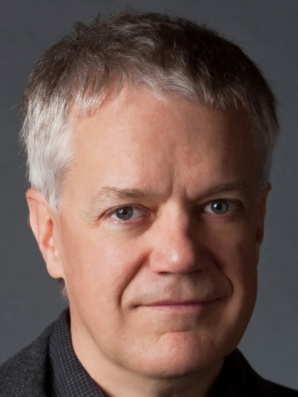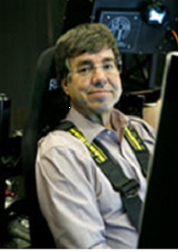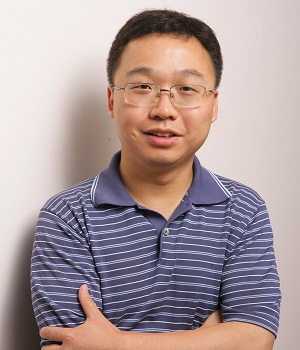Program
Chair: Ming C. Lin (University of North Carolina at Chapel Hill)

Vice President of Advanced Technology, Pixar Animation Studios
Title: Behind the Scenes at Pixar
AbstractThis talk takes you behind the scenes at Pixar Animation Studios for a look at how its 3D computer graphics films are made. The process starts with the development of the story and continues with modeling the geometry, animating the characters, simulating things like water and cloth and hair, defining the look of the surfaces, putting lights in the scene, and rendering the images. Making a computer animated film requires a close collaboration between artists and technical experts in many areas of expertise and is a great example of the value of bringing different disciplines together.
BioRob Cook was the co-architect and primary author of Pixar's RenderMan software, which creates photo-realistic computer images. In 2001, he and two colleagues received Oscars for their contributions, the first ever given for software. For 16 years, every film nominated for a Visual Effects Academy Award used RenderMan. He has a Bachelors degree in physics from Duke University and a Masters degree in Computer Graphics from Cornell University. At Cornell, he worked on simulating realistic surfaces, taking computer-generated images beyond the distinctive plastic look they had at the time. In 1981, he joined Lucasfilm/Pixar, where he developed the first programmable shader; programmable shading is now an essential part of GPUs and game engines as well as high-end renderers. He was the first to use Monte Carlo techniques in computer graphics, which was essential for simulation of complex, realistic lights and camera effects. The latter proved particularly important in the special effects industry, because it allowed computer-generated imagery to match the motion blur and depth of field of the live-action footage with which it was combined. In 1987, he received the ACM SIGGRAPH Computer Graphics Achievement Award in recognition of these contributions, and in 2009, he received the ACM SIGGRAPH Stephen A. Coons Award for his lifetime contributions to the field. In 1999, he was inducted as a Fellow of the Association for Computing Machinery. He has been named to the Academy of Motion Picture Arts and Sciences and to the National Academy of Engineering.
Chair: Ming Ouhyoung (National Taiwan University)

Director, Max Planck Institute for Biological Cybernetics
Title: Perceptual Graphics: closing the loop between Perception, Graphics and Computer Vision
AbstractIn our Perceptual Graphics group at the Max Planck Institute for Biological Cybernetics we integrate methods from psychophysics, computer graphics and computer vision in order to understand fundamental perceptual and cognitive processes. The fusion of methods from these research areas has the potential to greatly advance our understanding of perception and cognition. Highly controllable, yet realistic computer generated stimuli offer novel ways for psychophysical investigations. The results from those experiments can in turn be used to derive perceptual "shortcuts" to more efficient rendering approaches. Computer vision and machine learning algorithms can be used to model human cognition and action while conversely, the results from perceptual experiments can inform computer scientists how the brain solves problems and thus can lead to more efficient solutions of hard problems like recognition and categorization. In this presentation, I will highlight how the latest tools in computer vision, computer graphics, and virtual reality technology can be used to systematically understand the factors that determine how humans behave and solve tasks in realistic scenarios.
BioHeinrich Bülthoff is scientific member of the Max Planck Society and director at the Max Planck Institute for Biological Cybernetics in Tübingen. He is head of the Department Human Perception, Cognition and Action in which a group of about 70 researchers investigate psychophysical and computational aspects of higher level visual processes in object and face recognition, sensory-motor integration, spatial cognition, and perception and action in virtual environments. He holds a Ph.D. degree in the natural sciences from the Eberhard-Karls-Universität in Tübingen. From 1980 to 1988 he worked as a research scientist at the Max Planck Institute for Biological Cybernetics and the Massachusetts Institute of Technology and from 1988-1993 he was Assistant, Associate and Full Professor of Cognitive Science at Brown University in Providence. He is Honorary Professor at the Eberhard-Karls-Universität (Tübingen) and Korea University (Seoul) and Editor of several international journals.
Chair: Eugene Fiume (University of Toronto)

Professor, Zhejiang University
Title: Gradient Domain Shape Deformation
AbstractShape deformation is a useful tool in a variety of applications in shape modeling and computer animation. In recent years we have witnessed an increasing research interest in applying gradient domain techniques to shape deformation. Unlike traditional techniques such as FFD and multi-resolution methods which directly modify shape positions, gradient domain algorithms first modify shape gradients (or differential coordinates) and then reconstruct shape positions from the modified gradients. Such algorithms are able to preserve surface details and produce visually pleasing deformation results by distributing errors smoothly through global optimization. In this talk, I will review the origin of gradient domain shape deformation algorithms and give an overview of our recent research in this continuously evolving area.
BioKun Zhou is a Cheung Kong Professor in the computer science department of Zhejiang University, and a member of the State Key Laboratory of CAD&CG, where he leads the Graphics and Parallel Systems Lab. Prior to joining Zhejiang University in 2008, he was a Lead Researcher of the Internet Graphics Group at Microsoft Research Asia. He received his BS degree and PhD degree from Zhejiang University in 1997 and 2002, respectively. His research interests include computer graphics and parallel computing, in the areas of geometry processing, real-time rendering and GPU parallel computing. Please refer to http://kunzhou.net for more details about his research.
Session:
 Short Paper
Short Paper
 Short Presentation
Short PresentationChair: Yung-Yu Chuang (National Taiwan University)
| Motion Deblurring from a Single Image using Circular Sensor Motion | ||
| Yosuke Bando | Bing-Yu Chen | Tomoyuki Nishita |
| TOSHIBA / The University of Tokyo | National Taiwan University | The University of Tokyo |
| Edge-Optimized À-TrousWavelets for Local Contrast Enhancement with Robust Denoising | ||
| Johannes Hanika | Holger Dammertz | Hendrik Lensch |
| Ulm University / Weta Digital | Ulm University / RTT AG | Ulm University |
| Exposure Fusion for Time-Of-Flight Imaging | |
| Uwe Hahne | Marc Alexa |
| Technische Universität Berlin | |
| Rephotography Using Image Collections | ||
| Kun-Ting Lee | Sheng-Jie Luo | Bing-Yu Chen |
| National Taiwan University | ||
Chair: Wei-Chao Chen (SDI / National Taiwan University)
| Improving Performance and Accuracy of Local PCA | |||||
| Václav Gassenbauer | Jaroslav Krivánek | Kadi Bouatouch | Christian Bouville | Christian Bouville | Mickaël Ribardière |
| IRISA - INRIA Rennes / Czech Technical University in Prague | Charles University | IRISA - INRIA Rennes | |||
| Toward Optimal Space Partitioning for Unbiased, Adaptive Free Path Sampling of Inhomogeneous Participating Media | ||||
| Yonghao Yue | Kei Iwasaki | Bing-Yu Chen | Yoshinori Dobashi | Tomoyuki Nishita |
| The University of Tokyo | Wakayama University | National Taiwan University | Hokkaido University | The University of Tokyo |
| Interactive Indirect Illumination Using Voxel Cone Tracing | ||||
| Cyril Crassin | Fabrice Neyret | Miguel Sainz | Simon Green | Elmar Eisemann |
| INRIA Rhone-Alpes & LJK / Grenoble University | INRIA Rhone-Alpes & LJK / CNRS | NVIDIA | Telecom ParisTech | |
| Spatio-Temporal Filtering of Indirect Illumination for Real-Time Global Illumination | ||||
| Ying-Chieh Chen | Su Ian Eugene Lei | Chun-Fa Chang | ||
| National Tsing Hua University | National Taiwan Normal University | |||
| Real-time Realistic Voxel-based Rendering | ||||
| S.-H. Chang | Yu-Chi Lai | Yuzhen Niu | Feng Liu | K.-L. Hua |
| National Taiwan University of Science and Technology | Portland State University | National Taiwan University of Science and Technology | ||
| An Image-based Hair Styling System Using Layered Texture Pieces | |||
| Hiroki Watanabe | Yoshihiro Kanamori | Jun Mitani | Yukio Fukui |
| University of Tsukuba | |||
Chair: Pedro Sander (The Hong Kong University of Science and Technology)
| A Graph-based Approach to Continuous Line Illustrations with Variable Levels of Detail | |
| Fernando J. Wong | Shigeo Takahashi |
| The University of Tokyo | |
| An Illustrative Visualization Framework for 3D Vector Fields | ||||
| Cheng-Kai Chen | Shi Yan | Hongfeng Yu | Nelson Max | Kwan-Liu Ma |
| University of California, Davis | Sandia National Laboratories | University of California, Davis | ||
| Perceptually-based Stroke Pattern Synthesis | ||
| Dongwei Liu | Junsong Zhang | Changle Zhou |
| Xiamen University | ||
| Fast Level Set Image Segmentation Using New Evolution Indicator Operators | ||
| Chunxia Xiao | Jiajia Gan | Xiangyun Hu |
| Wuhan University | ||
| Fast Computing Adaptively Sampled Distance Field on GPU | ||
| Kangxue Yin | Youquan Liu | Enhua Wu |
| Chang'an Univeristy | Chang'an Univeristy / Chinese Academy of Sciences | Chinese Academy of Sciences / University of Macau |
| Two Simple Single-pass GPU methods for Multi-channel Surface Voxelization of Dynamic Scenes | ||||
| Athanasios Gaitatzes | Pavlos Mavridis | Georgios Papaioannou | ||
| University of Cyprus | Athens University of Economics & Business | |||
Chair: Yu-Shuen Wang (National Chiao Tung University)
| Motion Retrieval Using Low-Rank Subspace Decomposition of Motion Volume | ||
| Chuan Sun | Imran Junejo | Hassan Foroosh |
| University of Central Florida | University of Sharjah | University of Central Florida |
| Flexible Splicing of Upper-Body Motion Spaces on Locomotion | |
| Ben J. H. van Basten | Arjan Egges |
| Utrecht University | |
| Creating Fluid Animation from a Single Image using Video Database | ||
| Makoto Okabe | Ken Anjyo | Rikio Onai |
| The University of Electro-Communications / JST PRESTO | OLM Digital / JST CREST | The University of Electro-Communications |
| Asynchronous Evolution for Fully-Implicit and Semi-Implicit Time Integration | |||
| Craig Schroeder | Nipun Kwatra | Wen Zheng | Ron Fedkiw |
| Stanford University | Stanford University / Industrial Light+Magic | ||
Chair: Shigeo Takahashi (The University of Tokyo)
| SSD: Smooth Signed Distance Surface Reconstruction | |
| Fatih Calakli | Gabriel Taubin |
| Brown University | |
| Bipartite Polar Classification for Surface Reconstruction | |||
| Yi-Ling Chen | Tung-Ying Lee | Bing-Yu Chen | Shang-Hong Lai |
| Industrial Technology Research Institute / National Tsing Hua University | National Tsing Hua University | National Taiwan University | National Tsing Hua University |
| Discriminative Sketch-based 3D Model Retrieval via Robust Shape Matching | |||||
| Tianjia Shao | Weiwei Xu | Kangkang Yin | Jingdong Wang | Kun Zhou | Baining Guo |
| Tsinghua University | Microsoft Research Asia | National University of Singapore | Microsoft Research Asia | Zhejiang University | Microsoft Research Asia |
| An Effective and Efficient Contour-based Corner Detector using Simple Triangular Theory | ||
| R. M. Najmus Sadat | Shyh Wei Teng | Guojun Lu |
| Monash University | ||
| Feature Adaptive Surfel Set Simplification | |||
| Yan Huang | Feihu Yan | Bei Wang | Jingliang Peng |
| Shandong University | Intel | Shandong University | |
| Feature-Aware Reconstruction of Volume Data via Trivariate Splines | |||
| Bo Li | Hong Qin | ||
| Stony Brook University | |||
Chair: Tomoyuki Nishita (The University of Tokyo)
| Authoring Hierarchical Road Networks | |||
| Eric Galin | Adrien Peytavie | Eric Guérin | Bedrich Beneš |
| LIRIS - CNRS - Université Lumière Lyon | LIRIS - CNRS - Université Claude Bernard Lyon | LIRIS - CNRS - INSA Lyon | Purdue University |
| River Networks for Instant Procedural Planets | |||
| Evgenij Derzapf | Björn Ganster | Michael Guthe | Reinhard Klein |
| Philipps-Universität Marburg | Universität Bonn | Philipps-Universität Marburg | Universität Bonn |
| Virtual City Map Generation using Area Subdivision | ||||
| Kerstin Müller | Luc Heischbourg | Christoph Fünfzig | Sebastian Petsch | Hans Hagen |
| Technische Universität Kaiserslautern | ||||
| Local Poisson SPH For Viscous Incompressibility Fluids | ||||
| Xiaowei He | Ning Liu | Sheng Li | Hongan Wang | Guoping Wang |
| Peking University | ||||
| Sketch-based Breaking Waves | ||||
| Guijuan Zhang | Gaojin Wen | Dengming Zhu | Dianjie Lu | Shengzhong Feng |
| Chinese Academy of Sciences | ||||
| A Fast Simulation Method Using SPH and Wavelet for Sub-Particle-Scale Turbulent Flow | ||||
| Makoto Fujisawa | Go Mimura | Toshiyuki Amano | Jun Miyazaki | Hirokazu Kato |
| University of Tsukuba | Nintendo | Yamagata University | Nara Institute of Science and Technology | |
| Real-time Rendering of Endless Cloud Animation | ||
| Kei Iwasaki | Takanori Nishino | Yoshinori Dobashi |
| Wakayama University | Hokkaido University | |
Chair: Shang-Hong Lai (National Tsing Hua University)
| Real Time Edit Propagation by Efficient Sampling | ||
| Xiaohui Bie | Haoda Huang | Wencheng Wang |
| Chinese Academy of Sciences | Microsoft Research Asia | Chinese Academy of Sciences |
| Video Brush: A Novel Interface for Efficient Video Cutout | ||
| Ruo-Feng Tong | Yun Zhang | Meng Ding |
| Zhejiang University | ||
| RepSnapping: Efficient Image Cutout for Repeated Scene Elements | ||
| Hua Huang | Lei Zhang | Hong-Chao Zhang |
| Xi'an Jiaotong Unversity | ||
| A Single Image Representation Model for Efficient Stereoscopic Image Creation | ||||
| Younghui Kim | Hwi-ryong Jung | Sungwoo Choi | Jungjin Lee | Junyong Noh |
| Korea Advanced Institute of Science and Technology | ||||
Chair: Wenping Wang (The University of Hong Kong)
| Optimized Topological Surgery for Unfolding 3D Meshes | ||||
| Shigeo Takahashi | Hsiang-Yun Wu | Seow Hui Saw | Chun-Cheng Lin | Hsu-Chun Yen |
| The University of Tokyo | National Chiao Tung University | National Taiwan University | ||
| Computing 3D Shape Guarding and Star Decomposition | |
| Wuyi Yu | Xin Li |
| Xiamen University | Louisiana State University |
| HeatWalk: Robust Salient Segmentation of Non-rigid Shapes | |||
| William Benjamin | Andrew Wood Polk | S. V. N. Vishwanathan | Karthik Ramani |
| Purdue University | |||
| Interactive Design of Planar Curved Folding by Reflection | |
| Jun Mitani | Takeo Igarashi |
| University of Tsukuba / JST ERATO | The University of Tokyo / JST ERATO |
| Feature-Aware Mesh for Image Retargeting | ||
| Yuzhen Niu | Feng Liu | Yu-chi Lai |
| Portland State University | National Taiwan University of Science and Technology | |
| Facial Retargeting by Adding Supplemental Blendshapes | |||
| Paul Hyunjin Kim | Yeongho Seol | Jaewon Song | Junyong Noh |
| Korea Advanced Institute of Science and Technology | |||
Chair: Chuan-kai Yang (National Taiwan University of Science and Technology)
| Intelligent GPGPU Classification in Volume Visualization: A framework based on Error-Correcting Output Codes | |||
| Sergio Escalera | Anna Puig | Oscar Amoros | Maria Salamó |
| Universitat de Barcelona | |||
| Efficient Opacity Specification Based on Feature Visibilities in Direct Volume Rendering | ||||
| Yunhai Wang | Jian Zhang | Wei Chen | Huai Zhang | Xuebin Chi |
| Chinese Academy of Science | Zhejiang University | Chinese Academy of Science | ||
| Diffusion Tensor Weighted Harmonic Fields for Feature Classification | |||
| Shengfa Wang | Tingbo Hou | Zhixun Su | Hong Qin |
| Dalian University of Technology / Stony Brook University | Stony Brook University | Dalian University of Technology | Stony Brook University |
| Visualizing LocalWeather Characteristics Interpreted from Glider GPS Flight Logs | |||
| Tung-Ju Hsieh | Falko Kuester | Tara Hutchinson | |
| National Taipei University of Technology | University of California, San Diego | ||
| Illustrative Line Styles for Flow Visualization | |||
| Maarten H. Everts | Henk Bekker | Jos B. T. M. Roerdink | Tobias Isenberg |
| University of Groningen | University of Groningen / DIGITEO/CNRS/INRIA | ||

